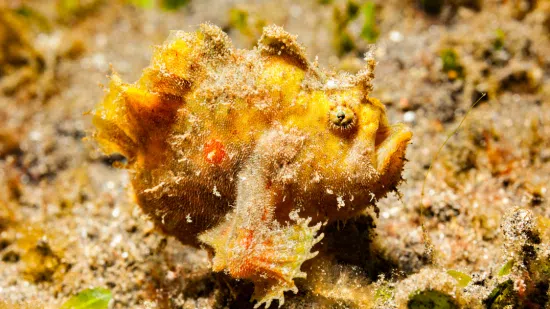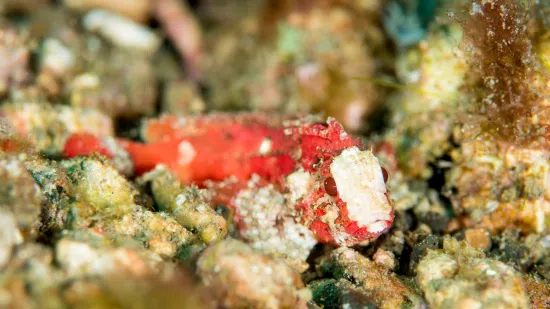Pygmy Tuberculated Frogfish
Antennatus tuberosus
(0 Reviews)

Pygmy Tuberculated Frogfish
Antennatus tuberosus
(0 Reviews)
{{ item.name }}
Size: {{ item.extra_field_3 }}
${{ getFormattedPrice(item.saleprice) }} ${{ getFormattedPrice(item.price) }}
To join the waiting list, click here
Free Shipping
With
$199.00
or more in Marine Life.
More details...
Pygmy Tuberculated Frogfish Care Facts
| Care Level: | Moderate |
|---|---|
| Temperament: | Peaceful |
| Diet: | Carnivore |
| Origin: | Indonesia |
| Acclimation Time: | 3+ hours |
| Reef Safe: | Yes |
| Minimum Tank Size: | 20 gallons |
| Maximum Size: | 4 inches |
The Pygmy Tuberculated Frogfish (Antennatus tuberosus) is a very fascinating addition to any aquarium. Frogfish are actually a type of angler fish, and do have a small antenna that they use to attract small crustaceans. They perch on branching corals and rocks in search of food and are very good at camoflage. They may eat frozen food in time, but usually only eat live food to start. Baby brine, copepods, and other small crustaceans are ideal for smaller specimen, and larger ones will feed on small fish/crustaceans. They are capable of eating fish nearly equal their own length, so use caution when housing with small damsels or clownfish.
The Pygmy Tuberculated Frogfish Care Guide From SaltWaterFish.com
Introducing the Pygmy Tuberculated Frogfish, a fascinating and captivating addition to saltwater marine aquariums. This comprehensive product description will give you all the essential information to consider when keeping this unique species in your aquarium.
Habitat of the Pygmy Tuberculated Frogfish: Native Marvels of the Indo-Pacific
Native to the Indo-Pacific region, the Pygmy Tuberculated Frogfish is often found in coral reefs, sandy bottoms, and seagrass beds at depths ranging from 5 to 30 meters. It is essential to replicate these natural conditions in captivity to ensure the health and well-being of this species.
Reef Compatibility of the Pygmy Tuberculated Frogfish
While many species of frogfish are not considered reef-safe due to their predatory nature, the Pygmy Tuberculated Frogfish is a relatively safe choice for reef aquariums. It tends to be less aggressive toward corals and other invertebrates, making it a suitable addition to a well-established reef environment.
Size and Lifespan of the Pygmy Tuberculated Frogfish
Pygmy Tuberculated Frogfish are small in size, with adults typically reaching a length of around 2 inches (5 centimeters). In captivity, they have a 2 to 4-year lifespan when provided with proper care.
Diet in Captivity of the Pygmy Tuberculated Frogfish
These fish are carnivorous predators and feed primarily on small crustaceans and other small fish in the wild. In captivity, they can be offered a diet of live or frozen foods such as brine shrimp, Mysis shrimp, and small pieces of fish. Ensuring a variety in their diet will help keep them healthy.
Aquaculture and Availability of the Pygmy Tuberculated Frogfish
Pygmy Tuberculated Frogfish are not commonly aquacultured, making them relatively rare in the aquarium trade. However, their availability may vary depending on your location and the availability of specialist marine fish retailers.
Compatibility of the Pygmy Tuberculated Frogfish with Other Fish and Invertebrates
While they are generally peaceful towards other fish, Pygmy Tuberculated Frogfish are known to be voracious predators and should not be housed with smaller fish or invertebrates that they may perceive as prey. Keeping them in a species-specific aquarium or with larger, non-aggressive tank mates is best.
Sexual Dimorphism of the Pygmy Tuberculated Frogfish
Sexual dimorphism in Pygmy Tuberculated Frogfish is not well-documented, and distinguishing males from females is challenging. Therefore, it is generally not a significant factor to consider when keeping this species.
Juvenile to Adult Coloration Changes in the Pygmy Tuberculated Frogfish: Chromatic Transformations
The Pygmy Tuberculated Frogfish displays remarkable coloration variations throughout its life. Juveniles often mimic the appearance of sponges or other encrusting organisms to camouflage themselves from potential predators. As they mature, their coloration may change to blend in with their surroundings better.
Temperament of the Pygmy Tuberculated Frogfish: Sedentary Charmers
These frogfish are generally sedentary and have a calm disposition, which makes them a captivating addition to aquariums. They are ambush predators, relying on their cryptic appearance to lure prey close before striking.
Tank Requirements for the Pygmy Tuberculated Frogfish: Crafting the Perfect Haven
- Minimum Aquarium Size: A 20-gallon (75-liter) aquarium should suffice for a single specimen, with larger tanks necessary for multiple individuals.
- Water Conditions:
- pH: 8.0 to 8.4
- Salinity: 1.020 to 1.025 specific gravity
- Water Temperature: 75°F to 80°F (24°C to 27°C)
- Water Flow: Low to moderate flow is suitable, as these fish are not strong swimmers and prefer calmer waters.
Other Common Names for the Pygmy Tuberculated Frogfish
The Pygmy Tuberculated Frogfish is also known by other common names, including the Tuberculated Frogfish and Tuberculate Anglerfish.
Five Compatible Tank Mates for the Pygmy Tuberculated Frogfish: Choosing the Right Companions
- Banggai Cardinalfish (Pterapogon kauderni): These peaceful, reef-friendly fish are suitable for a community tank.
- Firefish Goby (Nemateleotris magnifica): These colorful and timid gobies make excellent companions for the Pygmy Tuberculated Frogfish.
- Royal Gramma (Gramma loreto): These small, vibrant fish are known for their compatibility with other reef inhabitants.
- Cleaner Shrimp (Lysmata amboinensis): These helpful invertebrates not only add to the tank's biodiversity but also assist in maintaining a clean environment.
- Banded Coral Shrimp (Stenopus hispidus): These striking shrimp can coexist with the Pygmy Tuberculated Frogfish in a larger tank without posing a threat.
Why Choose Saltwaterfish.com: Your Trusted Source
Saltwaterfish.com is your trusted source for acquiring the Pygmy Tuberculated Frogfish for your marine aquarium. Here's why you should consider purchasing from us:
- Expertise: We are dedicated to providing accurate information and quality marine livestock.
- Selection: We offer a wide range of marine species, including the Pygmy Tuberculated Frogfish, to cater to all your aquarium needs.
- Careful Handling: We take pride in our careful and responsible handling and shipping practices to ensure your fish arrive healthy and thriving.
- Customer Support: Our experienced team is available to assist you with any questions or concerns, ensuring a smooth purchasing experience.
In conclusion, the Pygmy Tuberculated Frogfish (Antennatus tuberosus) is a captivating and unique addition to saltwater marine aquariums. With the right tank setup and proper care, you can enjoy the beauty and intrigue of this fascinating species in your own aquarium. When considering the acquisition of this fish, trust Saltwaterfish.com to provide you with quality specimens and expert support for a successful aquarium experience.
Currently Pygmy Tuberculated Frogfish does not have any reviews.















